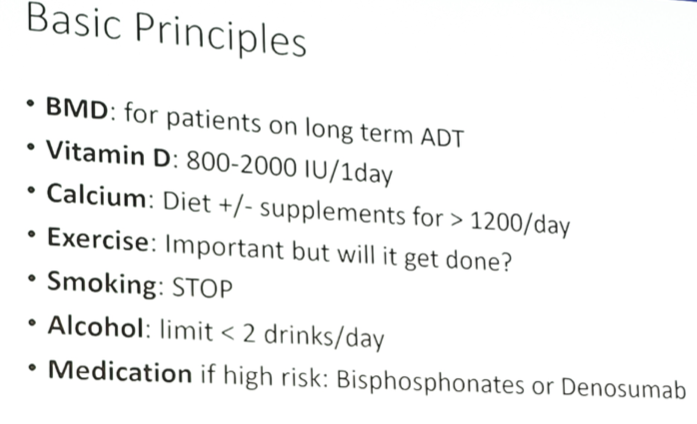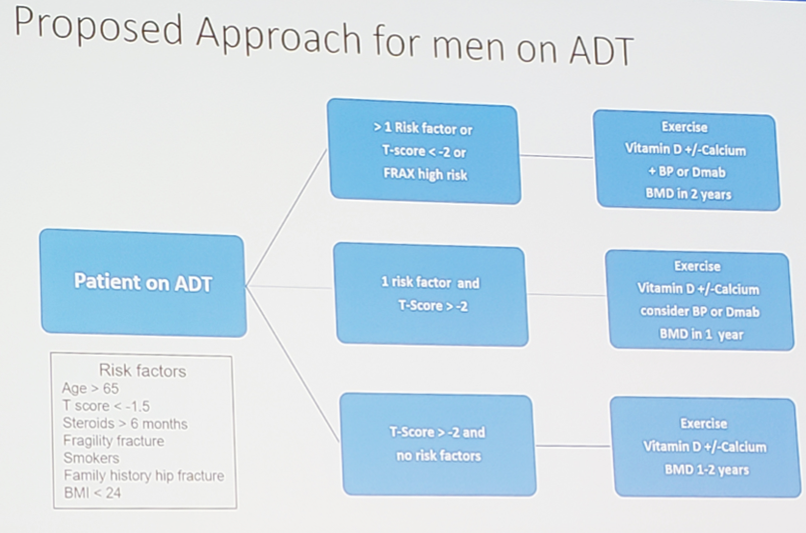Basel, Switzerland (UroToday.com) Prostate cancer leader Fred Saad, MD spoke at the bone and bone metastases session this afternoon at the Advanced Prostate Cancer Consensus Conference (APCCC) 19 by discussing the prevention and treatment of osteoporosis. According to Dr. Saad, the risks and consequences of osteoporosis are well-established: among all men, there is a 4.6% life-time risk of hip fractures, 21.5% prevalence of vertebral fractures, and 31-38% mortality rate 1-year after a hip fracture. The impact of ADT on associated significant bone-loss is also well-established, with a 4.6% lumbar spine bone mineral density loss at one year of therapy.
Given the relationship between ADT and bone loss, previous studies have established that ADT leads to increased fracture rates. Among 50,613 men in the SEER-Medicare database with a diagnosis of prostate cancer, Shahinian et al.1 assessed the occurrence of any fracture. Of men surviving at least five years after diagnosis, 19.4% of those who received ADT had a fracture, as compared with 12.6% of those not receiving ADT (p < 0.001). In the Cox proportional-hazards analyses, there was a statistically significant dose cumulative relationship between the number of doses of gonadotropin-releasing hormone received during the 12 months after diagnosis and the subsequent risk of fracture.
For calculating fracture risk, Dr. Saad recommends using the Fracture Risk Assessment Tool (FRAX), which are typically specific to a region of interest based on lifestyle, environmental factors, etc. Generally, all men >65 years of age should be considered for bone mineral density testing, whereas men 50-64 years of age should have testing if the individual (i) had a fragility fracture after age 40, (ii) prolonged glucocorticoids or other high-risk medications, (iii) parental hip fracture, (iv) vertebral fracture or osteopenia identified on radiography, (v) high alcohol intake or current smoking, (vi) low body weight (<60 kg) or major weight loss (> 10% of body weight at age 25), and (vii) other disorders strong associated with osteoporosis.
Algorithms also exist for deciding who to treat for osteoporosis. Certainly, anyone deemed high-risk should be treated: ie. those with a 10-year fracture risk >20% or prior fragility fracture of the hip or spine or >1 fragility fracture. For men at moderate risk (10-year fracture risk of 10-20%), lateral thoracolumbar radiography (T4-L4) or vertebral fracture assessment may aid in decision making by identifying vertebral fractures. Several other pertinent factors warranting consideration for treatment are all men undergoing ADT therapy, and long-term or repeated use of systemic glucocorticoids (ie. prednisone during abiraterone).
According to Dr. Saad, basically all bone health agents work – these include pamidronate, alendronate, and denosumab – and it is just a matter of selecting one and using it. Dr. Saad’s basic principles for decreasing bone loss for men with advanced prostate cancer is as follows:

As has been discussed during other presentations at this meeting, the increased fracture rate in the abiraterone + radium 223 arm of ERA 223, particularly the early event rate, is a sobering reminder of the importance for bone-targeted agents. But, as Dr. Saad points out, this is not unique to abiraterone + radium 223, as the fracture rate in SPARTAN, PROSPER, and PREVAIL ranged from 9-12% in the treatment arm, while bone-targeted agent utilization ranging from only 10-40%.
Dr. Saad concluded his presentation with the following algorithm for men on ADT:

Presented by: Fred Saad, MD, FRCS, Full Professor and Chief of Urologic Oncology, Medical Director of Interdisciplinary Urologic Oncology Group, Department of Surgery/Faculty of Medicine; Institut du cancer de Montréal/CRCHUM
Written by: Zachary Klaassen, MD, MSc – Assistant Professor of Urology, Georgia Cancer Center, Augusta University/Medical College of Georgia Twitter: @zklaassen_md at the 2019 Advanced Prostate Cancer Consensus Conference (APCCC) #APCCC19, Aug 29 – 31, 2019 in Basel, Switzerland
References:
- Shahinian VB, Kuo YF, Freeman JL, Goodwin JS. Risk of fracture after androgen deprivation therapy for prostate cancer. N Engl J Med 2005 Jan 13;352(2):154-164.
- Smith M, Parker C, Saad F, et al. Addition of radium-223 to abiraterone acetate and prednisone or prednisolone in patients with castration-resistant prostate cancer and bone metastases (ERA 223): A randomized, double-blind, placebo-controlled, phase 3 trial. Lancet Oncol 2019 Mar;20(3):408-419.
